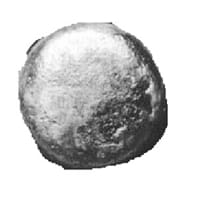Plutonium vs Radium
Periodic Table
Symbol
Pu
Ra
Group Number
0
18
2
16
Period Number
7
7
Block
f block
s block
Element Family
Actinide
Alkaline Earth
CAS Number
7440075
99+
7440144
99+
Space Group Name
P121/m1
Im_ 3m
Space Group Number
11.00
13
229.00
1
Facts
Interesting Facts
- Plutonium metal if obtain from ores of uranium metal.
- Plutonium metal is very sensitive to the change in atmospheric conditions like temperature and pressure.
- Radium metal is the heaviest metal of Alkaline earth metals column.
- Radium metal is highly radioactive and does not have any stable isotopes.
Sources
Mining, Ores of metals
Mining, Ores of metals
History
Who Discovered
Glenn T. Seaborg, Arthur Wahl, Joseph W. Kennedy, Edwin McMillan
Not Available
Discovery
In Between 1940 1941
In 1898
Abundance
Abundance In Earth's Crust
Not Available
0.00 %
99+
Abundance In Oceans
Not Available
0.00 %
99+
Abundance In Humans
Not Available
0.00 %
20
Uses
Uses & Benefits
- Plutonium was used in atomic bombs and still it is being used in various weapons and Ammunition industry.
- It is also used in nuclear power plant as source of energy for space missions.
- It is a highly radioactive metal; and sometime Radium-223 is used to treat prostate cancer.
- It is used in luminous paints.
Industrial Uses
Aerospace Industry, Ammunition Industry
NA
Medical Uses
NA
Pharmaceutical Industry
Other Uses
Alloys
NA
Biological Properties
Toxicity
Toxic
Highly Toxic
Present in Human Body
No
No
In Blood
0.00 Blood/mg dm-3
37
Not Available
In Bone
0.00 p.p.m.
36
Not Available
Physical Properties
Melting Point
639.50 °C
99+
700.00 °C
99+
Boiling Point
3,235.00 °C
24
1,737.00 °C
99+
Appearance
Physical State
Solid
Solid
Color
Silvery White
Silvery White
Luster
NA
Metallic
Hardness
Speed of Sound
2,260.00 m/s
99+
Not Available
Optical Properties
Allotropes
No
No
α Allotropes
Not Available
Not Available
β Allotropes
Not Available
Not Available
γ Allotropes
Not Available
Not Available
Chemical Properties
Chemical Formula
Pu
Ra
Isotopes
Known Isotopes
20
19
33
6
Electronegativity
Pauling Electronegativity
1.28
33
0.90
99+
Allred Rochow Electronegativity
1.22
26
0.97
38
Mulliken-Jaffe Electronegativity
Not Available
0.92
20
Allen Electronegativity
Not Available
0.89
99+
Electropositivity
Pauling Electropositivity
2.72
21
3.10
5
Ionization Energies
1st Energy Level
584.70 kJ/mol
99+
509.30 kJ/mol
99+
2nd Energy Level
1,128.00 kJ/mol
99+
979.00 kJ/mol
99+
3rd Energy Level
2,084.00 kJ/mol
99+
Not Available
4th Energy Level
3,338.00 kJ/mol
99+
Not Available
Electrochemical Equivalent
2.28 g/amp-hr
22
4.22 g/amp-hr
6
Electron Work Function
Not Available
Not Available
Other Chemical Properties
Corrosion, Ionization, Radioactive Isotopes, Radioactivity
Ionization, Radioactive Isotopes, Radioactivity
Atomic Properties
Atomic Number
94
24
88
30
Electron Configuration
[Rn] 5f6 7s2
[Rn] 7s2
Crystal Structure
Monoclinic (MON)
Body Centered Cubic (BCC)
Crystal Lattice
MON-Crystal-Structure-of-Plutonium.jpg#100
BCC-Crystal-Structure-.jpg#100
Atom
Number of Protons
94
24
88
30
Number of Neutrons
150
11
138
16
Number of Electrons
94
24
88
30
Radius of an Atom
Atomic Radius
159.00 pm
28
Not Available
Covalent Radius
187.00 pm
20
221.00 pm
3
Van der Waals Radius
200.00 pm
28
283.00 pm
4
Atomic Weight
244.00 amu
19
226.00 amu
26
Atomic Volume
12.32 cm3/mol
99+
45.20 cm3/mol
4
Adjacent Atomic Numbers
Valence Electron Potential
64.90 (-eV)
21
20.10 (-eV)
99+
Lattice Constant
618.30 pm
4
514.80 pm
13
Lattice Angles
NA
π/2, π/2, π/2
Lattice C/A Ratio
Not Available
Not Available
Mechanical Properties
Density
Density At Room Temperature
19.82 g/cm3
13
5.50 g/cm3
99+
Density When Liquid (at m.p.)
16.63 g/cm3
8
Not Available
Tensile Strength
Not Available
Not Available
Viscosity
Not Available
Not Available
Vapor Pressure
Vapor Pressure at 1000 K
0.00 (Pa)
26
Not Available
Vapor Pressure at 2000 K
2.20 (Pa)
12
Not Available
Elasticity properties
Shear Modulus
43.00 GPa
18
Not Available
Young's Modulus
96.00 GPa
21
Not Available
Poisson Ratio
0.21
32
Not Available
Other Mechanical Properties
Ductile, Malleable
NA
Magnetic Properties
Magnetic Characteristics
Specific Gravity
19.84
7
5.00
99+
Magnetic Ordering
Paramagnetic
Nonmagnetic
Electrical Properties
Electrical Property
Poor Conductor
NA
Resistivity
1.46 nΩ·m
99+
100.00 nΩ·m
31
Electrical Conductivity
0.01 106/cm Ω
99+
Not Available
Thermal Properties
Specific Heat
0.13 J/(kg K)
39
0.12 J/(kg K)
40
Molar Heat Capacity
35.50 J/mol·K
3
Not Available
Thermal Conductivity
6.74 W/m·K
99+
18.60 W/m·K
99+
Critical Temperature
Not Available
Not Available
Thermal Expansion
46.70 µm/(m·K)
6
Not Available
Enthalpy
Enthalpy of Vaporization
344.00 kJ/mol
25
Not Available
Enthalpy of Fusion
2.82 kJ/mol
99+
Not Available
Enthalpy of Atomization
360.00 kJ/mol
26
163.00 kJ/mol
99+
Standard Molar Entropy
Not Available
71.00 J/mol.K
14
|
||
|
||
|












